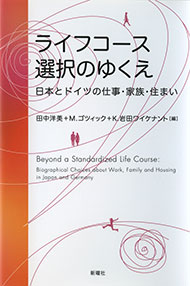
Einzelheiten
2013, ISBN 9784788513242, Shinyōsha, Tokyo, 380 S.Autoren
Iwata-Weickgenannt, Kristina
Tanaka, Hiromi
Godzik, Maren
Tanaka, Hiromi
Godzik, Maren
Beyond a Standardized Life Course
Biographical Choices about Work, Family and Housing in Japan and Germany

„Zwischen Ausweitung individueller Wahlmöglichkeiten und wachsender Unsicherheit“ ‒ dieser Band geht für Japan und Deutschland der Entwicklung und Bedeutung der Normalbiographie nach und untersucht die Effekte von Alterung, Bevölkerungsschrumpfung sowie struktureller Veränderungen auf dem Arbeitsmarkt. Im Mittelpunkt stehen die Lebensbereiche Arbeit, Familie und Wohnen. Die für Frauen und Männer, Jung und Alt durchaus unterschiedlichen neuen Herausforderungen und Chancen werden ebenso untersucht wie die Verhandlung dieser Veränderungen in Literatur und Populärkultur.
Inhalt
Shimazaki, Naoko
'Diversification of Individual Lives' and Life Courses: Institutionalization, Standardization, Individualization in Japan
S. 2-22
'Diversification of Individual Lives' and Life Courses: Institutionalization, Standardization, Individualization in Japan
S. 2-22
Imai, Jun
Employment Reforms and Career: Diversification of Work and the Workers' Conflicts over 'Individual Lives' in Japan
S. 50-73
Employment Reforms and Career: Diversification of Work and the Workers' Conflicts over 'Individual Lives' in Japan
S. 50-73
Kamata, Akihito
Working without Being Employed: Life Courses and Signs of ‘New Way of Work’ In Japan
S. 74-102
Working without Being Employed: Life Courses and Signs of ‘New Way of Work’ In Japan
S. 74-102
Ishiguro, Kuniko; Matanle, Peter
Men's and Women's Life Courses in Salaryman Manga: Analysis of Shima Kosaku and Salaryman Kintaro
S. 103-132
Men's and Women's Life Courses in Salaryman Manga: Analysis of Shima Kosaku and Salaryman Kintaro
S. 103-132
Apitzsch, Birgit
Flexibilization in The German Labor Market: Towards a Self-Directed Working Life in Germany's Media Industry?
S. 133-157
Flexibilization in The German Labor Market: Towards a Self-Directed Working Life in Germany's Media Industry?
S. 133-157
Tanaka, Hiromi
Biographical Choices of Unmarried Employed Women: ‘Normal Deviance’ in the Japanese Context
S. 158-183
Biographical Choices of Unmarried Employed Women: ‘Normal Deviance’ in the Japanese Context
S. 158-183
Iwata-Weickgenannt, Kristina
De-standardization of Life Courses and Representations of Singlehood in the TV Dramas Around 40 and Konkatasu
S. 184-208
De-standardization of Life Courses and Representations of Singlehood in the TV Dramas Around 40 and Konkatasu
S. 184-208
Hidaka, Yoshida
Place without a Wife: Time and Space of 'Boku' in Murakami's The Wind-Up Bird Chronicle
S. 209-231
Place without a Wife: Time and Space of 'Boku' in Murakami's The Wind-Up Bird Chronicle
S. 209-231
Taga, Futoshi
Children as Risk? The Changing Meaning of Childrearing for Japanese Male Employees' Life
S. 232-253
Children as Risk? The Changing Meaning of Childrearing for Japanese Male Employees' Life
S. 232-253
Meuser, Michael
The Discovery of the 'New Fathers': The Ambivalence of Active Fatherhood in Germany
S. 254-276
The Discovery of the 'New Fathers': The Ambivalence of Active Fatherhood in Germany
S. 254-276
Hirayama, Yosuke
Young People’s Life Courses and Housing Policy in Japan
S. 276-301
Young People’s Life Courses and Housing Policy in Japan
S. 276-301
Godzik, Maren
Life Courses, Housing and Elderly Women in Japan: Why do They Choose Communal Living?
S. 302-332
Life Courses, Housing and Elderly Women in Japan: Why do They Choose Communal Living?
S. 302-332
Becker, Ruth
The Post-war Development of Women's Life Patterns and Housing in Germany
S. 332-359
The Post-war Development of Women's Life Patterns and Housing in Germany
S. 332-359
Mathews, Gordon
Ikigai [purpose in life] and Changing Life Courses in Japan
S. 360-380
Ikigai [purpose in life] and Changing Life Courses in Japan
S. 360-380